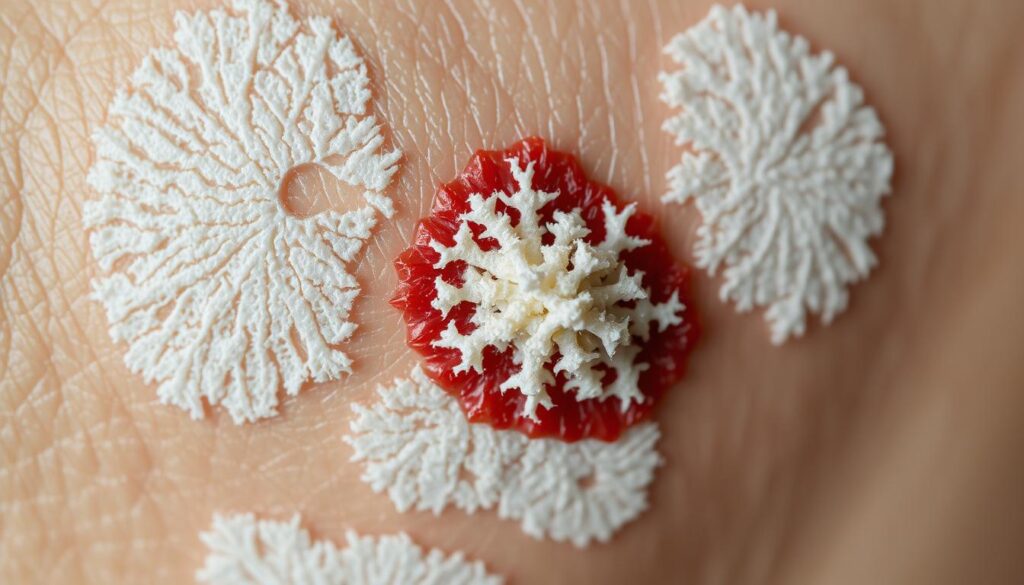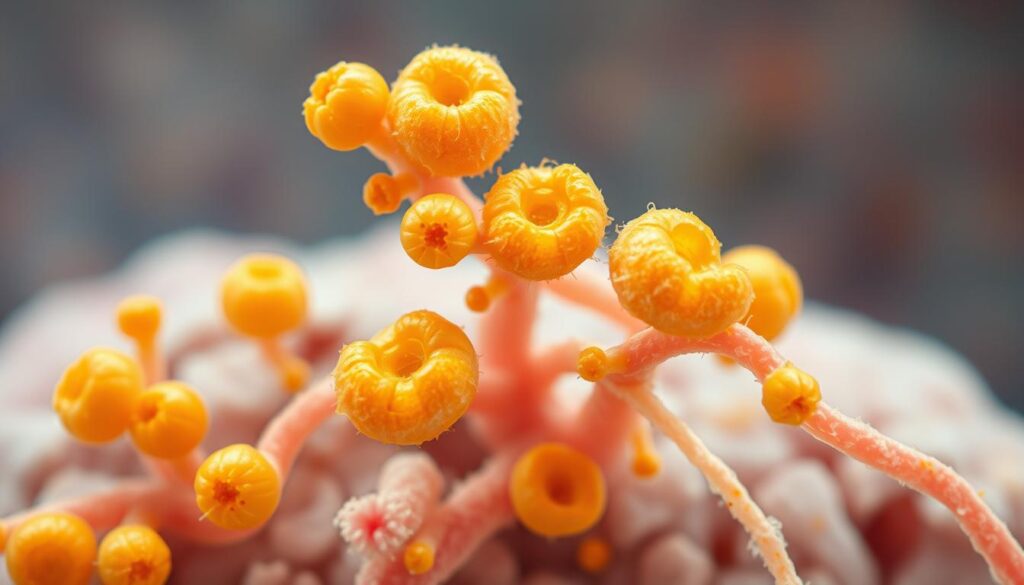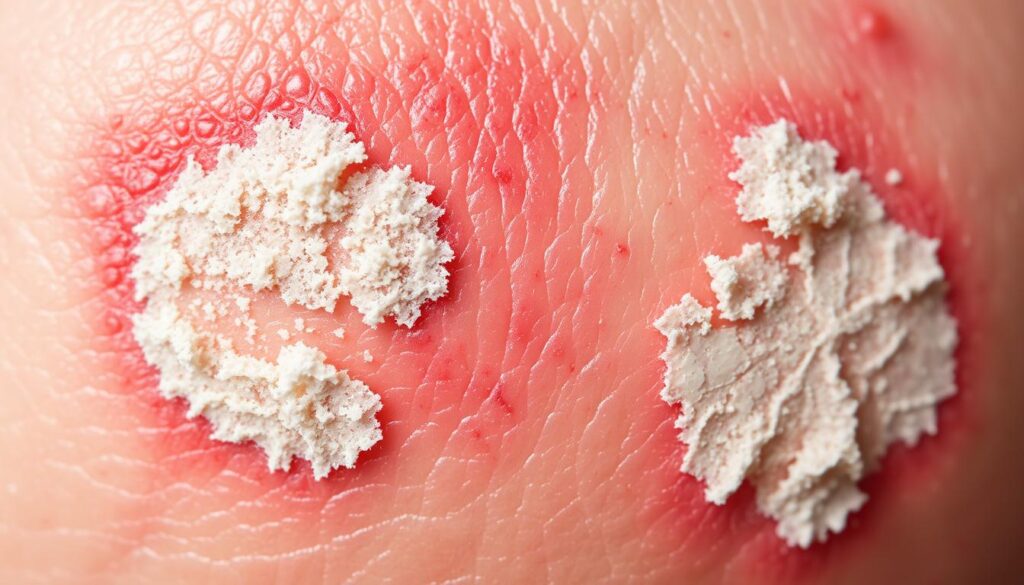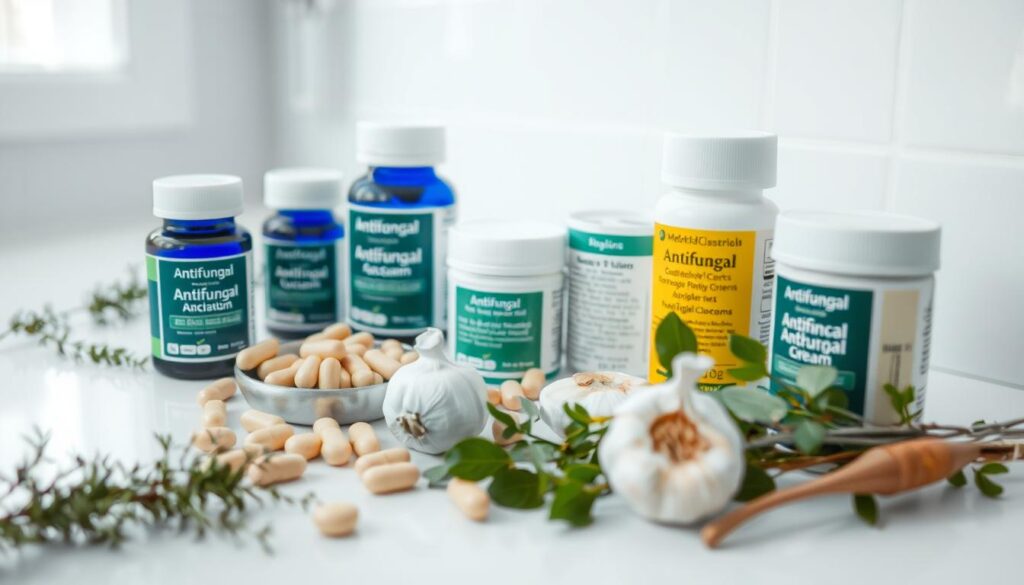Did you know candidiasis, also known as moniliasis, is a common fungal infection worldwide? It’s estimated that up to 75% of all women will get a vaginal yeast infection caused by Candida fungus at some point. This fungus can cause health issues, from oral thrush to serious infections.
It’s important to know about candidiasis to stay healthy. In this guide, we’ll explore the causes, symptoms, and how to manage candidiasis. We’ll look at different Candida species, where they infect, risk factors, and the key role of Candida albicans. By the end, you’ll know how to spot, prevent, and treat candidiasis.

Key Takeaways
- Candidiasis or moniliasis is a common fungal infection caused by Candida species
- Up to 75% of women will experience a vaginal yeast infection in their lifetime
- Candida albicans is the most prevalent species responsible for fungal infections
- Candidiasis can affect various body parts, from the mouth to the skin
- Risk factors include antibiotic use, diabetes, pregnancy, and a weakened immune system
Understanding Moniliasis or Candidiasis Diseases
Moniliasis, also known as candidiasis, is a fungal infection. It’s caused by Candida, a type of yeast that lives in our bodies. Usually, Candida is harmless. But, an overgrowth can lead to candidiasis, a serious health issue.
Types of Candida Species
Candida albicans is the main cause of candidiasis, making up 90% of infections. Other species like Candida glabrata, Candida krusei, and Candida tropicalis can also cause infections. This is especially true for people with weak immune systems.
Common Areas of Infection
Candidiasis can occur in many body parts. This includes the mouth, throat, esophagus, vagina, skin, and bloodstream. Mucosal candidiasis, which affects moist surfaces, is very common. It can be very uncomfortable for those who have it.
Risk Factors and Susceptibility
- Weakened immune system, such as in individuals with HIV/AIDS, cancer, or organ transplants
- Prolonged use of antibiotics or corticosteroids
- Diabetes, especially when blood sugar levels are poorly controlled
- Pregnancy and hormonal changes
- Poor hygiene or excessive moisture in the affected area
The Role of Candida Albicans in Fungal Infections
Candida albicans is a common cause of fungal infections called candidiasis. It’s usually harmless, living in places like the mouth, gut, and vagina. But, it can become a problem if it grows too much.
Things like antibiotics, a weak immune system, diabetes, or hormonal changes can help Candida grow. When this happens, it can lead to infections. These can affect the mouth, vagina, skin, nails, or even the bloodstream and organs.
- Oral thrush
- Vaginal yeast infections
- Skin and nail infections
- Invasive candidiasis, affecting the bloodstream, organs, and other internal systems
Knowing how Candida albicans causes infections helps doctors treat it better. It helps them find the right treatments and teach patients how to manage their infections.

“Candida albicans is an opportunistic pathogen that can exploit disruptions in the body’s natural defenses to cause a wide range of fungal infections.”
Signs and Symptoms of Candidiasis
Candidiasis, also known as thrush or vaginal candidiasis, can affect health in many ways. It’s important to know the common signs and symptoms. This helps people recognize the condition and get medical help quickly.
Physical Manifestations
One clear sign of candidiasis is white, cottage cheese-like patches on the tongue, inner cheeks, or throat. This is called oral thrush. For vaginal candidiasis, look out for irritation, redness, and a thick, white discharge that looks like cottage cheese.
Systemic Symptoms
Candidiasis can also cause symptoms that affect the whole body. These include fatigue, digestive issues, and recurring yeast infections. People might also have skin rashes, joint pain, and brain fog. These signs suggest a bigger fungal problem.
Warning Signs to Watch For
- Persistent or recurring oral thrush or vaginal candidiasis
- Intense itching, burning, or discomfort in the affected areas
- Sudden or unexplained changes in mood, energy levels, or cognitive function
- Difficulty controlling blood sugar levels, which can increase susceptibility to candidiasis
It’s key to spot and treat candidiasis symptoms early. This stops the condition from getting worse and prevents serious problems. Getting medical help fast can help manage symptoms and improve overall health.
Oral Thrush: Causes and Manifestations
Oral thrush, also known as mucosal candidiasis, is a common fungal infection. It affects the mouth and throat. It’s caused by an overgrowth of the Candida albicans fungus, which is normally found in the mouth.
It can happen to anyone, but some groups are more at risk. This includes people with weakened immune systems, like those with HIV/AIDS or cancer. Also, infants and older adults are more likely to get it because their immune systems are not as strong.
The symptoms of oral thrush can vary. You might see white, creamy patches on your tongue, cheeks, gums, or throat. These patches can be painful and make your mouth feel sore or burn. In severe cases, the infection can spread to the esophagus, making it hard to swallow.
“Oral thrush is a common and treatable condition, but it’s important to recognize the signs and seek medical attention if the symptoms persist or worsen.”
To prevent oral thrush, keep your mouth clean and manage any health issues. Also, avoid certain medicines that can upset the balance of bacteria in your mouth. If you think you have oral thrush, see a doctor for the right treatment.

Vaginal Candidiasis: Understanding Yeast Infections
Vaginal candidiasis, or yeast infection, is a common fungal infection in women. It’s caused by an overgrowth of Candida fungus in the vagina. Normally, Candida is present in small amounts. But, an imbalance can cause a yeast infection.
Common Triggers
Several factors can lead to vaginal candidiasis. These include:
- Antibiotics, which can upset the vaginal bacteria balance
- Hormonal changes, like during pregnancy or menstruation
- Diabetes or other conditions that weaken the immune system
- Wearing tight, synthetic underwear or clothing that traps moisture
- Douching or using scented feminine products
Treatment Options
Vaginal candidiasis is treatable. Over-the-counter antifungal creams or suppositories are often the first choice. For severe or recurring cases, prescription medications might be needed. Always follow a healthcare professional’s instructions for treatment.
Prevention Strategies
To prevent vaginal candidiasis, consider these tips:
- Wear loose, breathable underwear and clothing
- Avoid scented feminine products or douching
- Keep the genital area clean and dry
- Manage any underlying health conditions, such as diabetes
- Practice safe sex and limit sexual partners
Understanding the causes, treatments, and prevention of vaginal candidiasis helps women protect their vaginal health. This reduces the risk of recurring yeast infections.
Cutaneous Candidiasis and Skin Manifestations
Candidiasis is a fungal infection caused by Candida species. It can affect the skin and nails, causing visible symptoms. These symptoms can be uncomfortable and unsightly.
Candidal intertrigo is a common form of cutaneous candidiasis. It happens in moist, warm areas like the armpits, groin, and under the breasts. Symptoms include reddish, itchy rashes and moist skin.
- Candidal paronychia affects the skin around the nails. It can cause inflammation, redness, and pus.
- Candidal onychomycosis is a fungal nail infection. It can make nails discolored, thick, and brittle.
- Diaper rash in infants is also a sign of cutaneous candidiasis. It causes irritation and discomfort in the diaper area.
People with weakened immune systems, diabetes, or on certain medications are at risk. Proper diagnosis and treatment are key. This may include antifungal creams or oral medications.

“Candidiasis can have a significant impact on a person’s quality of life, both physically and emotionally. Prompt treatment and addressing the underlying causes are crucial for effective management.”
Understanding cutaneous candidiasis and its symptoms helps individuals recognize signs. Seeking medical attention is important. Proper prevention and management can reduce discomfort and complications.
Diagnostic Approaches for Candidal Infections
It’s important to accurately diagnose candidal infections like moniliasis or candidiasis. Healthcare providers use lab tests and clinical exams to find the cause. This helps them create a treatment plan that fits the patient.
Laboratory Testing Methods
Healthcare providers may use several lab tests to confirm a candidal infection:
- Fungal culture: A sample is taken and grown in a lab to find the Candida species.
- Microscopic examination: Samples are looked at under a microscope for yeast cells or fungal structures.
- Molecular testing: Techniques like PCR assays quickly find Candida genetic material for a precise diagnosis.
Clinical Examination Procedures
Healthcare providers also do a detailed clinical exam. They check symptoms and physical signs of candidiasis. This includes:
- Visual inspection: They look for lesions, rashes, or color changes in the affected areas.
- Palpation: They feel the skin or mucous membranes for swelling or abnormalities.
- Symptom assessment: They talk to the patient about symptoms like itching, burning, or pain.
By combining lab results with a detailed clinical exam, healthcare providers can accurately diagnose candidal infections. They then create a treatment plan that’s right for the patient.
Treatment Options and Medical Interventions
Treating fungal infections, like thrush or candidiasis, needs a mix of medical help and care tailored to each person. The treatment depends on the type, how bad it is, and what caused the fungal infection.
Antifungal Medications
Antifungal meds, both for the skin and taken by mouth, are key in fighting candidiasis. These meds target the fungus, stopping it from growing and spreading. Doctors might give you creams, ointments, or pills, based on where and how bad the infection is.
Topical Treatments
For fungal infections in one area, like mouth thrush or skin candidiasis, creams or ointments are often first. These include:
- Antifungal creams or powders
- Medicated lozenges or gargles for oral thrush
- Antifungal vaginal suppositories or creams for vaginal candidiasis
Systemic Therapies
For serious or ongoing fungal infections, doctors might suggest meds taken by mouth or given through an IV. These meds fight the fungus all over the body. They’re especially helpful for serious cases or in people with weakened immune systems.
| Treatment Type | Examples | Typical Use |
|---|---|---|
| Topical Antifungals | Miconazole, Clotrimazole, Nystatin | Localized fungal infections, such as oral thrush or skin candidiasis |
| Oral Antifungals | Fluconazole, Itraconazole, Ketoconazole | Systemic fungal infections, recurrent or severe cases |
| Intravenous Antifungals | Amphotericin B, Caspofungin, Micafungin | Severe or life-threatening fungal infections, often in immunocompromised patients |
It’s crucial to follow your doctor’s advice and finish the treatment. This ensures the fungal infection is well managed and doesn’t come back.

Natural Remedies and Alternative Treatments
Many people are looking into natural ways to fight yeast infections and candida albicans. These methods are seen as gentler and more natural. They offer hope for those wanting to avoid harsh treatments.
Dietary Modifications
Changing what you eat is a big part of fighting candida albicans. Eating foods that fight fungus and help good bacteria can help. Here are some tips:
- Eat more fermented foods like kefir, sauerkraut, and kimchi. They’re full of good bacteria.
- Drink less sugar and processed foods. They feed candida.
- Add garlic, ginger, turmeric, and oregano to your meals. They have antifungal powers.
- Drink lots of water. It helps your body get rid of toxins.
Herbal Supplements
Herbal supplements can also help with yeast infections and candida albicans. Some herbs are especially good:
- Oregano oil is very good at fighting fungus. It stops candida from growing.
- Caprylic acid, from coconut oil, breaks down candida cells.
- Pau d’arco is a South American herb that helps fight fungus naturally.
- Berberine, found in plants like goldenseal, fights off bad bacteria and inflammation.
Always talk to a doctor before taking herbal supplements. They can interact with other medicines or cause side effects.
Natural remedies and alternative treatments can be helpful. But, it’s key to work with a doctor to find the best plan. A mix of diet changes, herbal supplements, and medical treatments might work best for long-term health.
Prevention Strategies and Lifestyle Changes
Good personal hygiene and healthy habits are key to avoiding moniliasis and candidiasis. Knowing the risks and taking simple steps can help keep Candida in check. This way, you can lower the chance of getting these fungal infections.
Keeping your genital area clean and dry is a big part of prevention. Wear clothes that breathe and don’t trap moisture. Also, wash your hands often to stop Candida from spreading.
- Maintain good personal hygiene, including regular hand washing and keeping the genital area clean and dry.
- Wear breathable, moisture-wicking undergarments and avoid tight-fitting or synthetic clothing.
- Maintain a balanced and nutritious diet rich in probiotic-containing foods, such as yogurt, kefir, and fermented vegetables.
- Avoid excessive consumption of refined carbohydrates, sugary foods, and alcohol, as these can disrupt the body’s Candida balance.
- Manage stress levels through relaxation techniques, such as meditation, yoga, or deep breathing exercises.
- Consult with a healthcare professional before taking any antibiotics, as they can disrupt the natural balance of Candida in the body.
By following these tips, you can help keep Candida in balance. This reduces the risk of moniliasis or candidiasis infections.
Complications of Untreated Candidiasis
Candidiasis, also known as a fungal infection, can cause serious problems if not treated. These issues can affect people in the short and long term. This is especially true for those with compromised immune systems or other health problems.
Short-term Effects
In the short term, untreated candidiasis can lead to many uncomfortable symptoms. These include:
- Persistent pain or discomfort in the affected area
- Increased risk of secondary bacterial or viral infections
- Difficulty swallowing, eating, or drinking
- Skin irritation, redness, and scaling
These symptoms can really lower someone’s quality of life. They may also lead to more serious problems if not treated quickly.
Long-term Consequences
Untreated candidiasis can have lasting effects, especially for those with weak immune systems. This includes people with HIV/AIDS, cancer, or organ transplants. Some long-term effects are:
- Chronic inflammation and tissue damage in the affected areas
- Increased risk of systemic fungal infections that can spread to other organs
- Difficulty managing other underlying health conditions due to the compromised immune system
- Increased susceptibility to additional opportunistic infections
In severe cases, untreated candidiasis can even be life-threatening. This shows how important it is to get medical help quickly and follow the treatment plan.
“Prompt diagnosis and treatment of candidiasis are crucial to prevent the development of serious complications, especially for individuals with weakened immune systems.”
Special Considerations for Immunocompromised Patients
Candidiasis, or candidal infections, is a big risk for people with weak immune systems. Those with HIV/AIDS, cancer, organ transplants, or autoimmune disorders are especially at risk. These infections can be very dangerous.
People with weak immune systems often get worse infections. Their bodies can’t fight off the Candida fungus well. They might get oral thrush, vaginal candidiasis, or even life-threatening infections.
It’s very important to find and treat candidiasis quickly in these patients. Doctors use tests and exams to find the right treatment. This helps fight the infection.
For these patients, treatment goes beyond just medicine. Changing their diet and using natural remedies can help. Eating less sugar and more probiotics can boost their immune system.
It’s key for these patients to stay in close touch with their doctors. This helps manage candidiasis and prevent serious problems. Doctors can create special plans to help these patients live better lives.
“Immunocompromised patients require a tailored approach to managing candidiasis, as their condition puts them at a higher risk of severe and persistent fungal infections.”
When to Seek Medical Attention
It’s important to know the signs of thrush or vaginal candidiasis to get medical help on time. Some mild cases can be treated at home. But, some situations need a doctor’s care.
If you have ongoing, severe, or frequent symptoms, see a healthcare provider. These include:
- Intense vaginal itching, burning, or discomfort
- Thick, white, cottage cheese-like vaginal discharge
- Painful intercourse or urination
- Redness, swelling, or irritation of the vulva or vagina
- Oral thrush with white, painful lesions in the mouth or throat
People with weak immune systems, like those with HIV/AIDS, cancer patients, or diabetics, should watch closely. They should get medical help fast if they see any candidiasis signs. Quick action is key to avoid problems and treat the infection well.
| Symptom | Recommended Action |
|---|---|
| Mild, occasional vaginal discomfort | Try over-the-counter treatments or home remedies |
| Persistent, severe, or recurring symptoms | Consult a healthcare provider for proper diagnosis and treatment |
| Symptoms in individuals with weakened immune systems | Seek immediate medical attention |
Early detection and quick treatment are key to manage thrush and vaginal candidiasis well. Don’t wait to get professional advice if you’re worried or have bad symptoms.
Conclusion
Moniliasis or candidiasis diseases are common fungal infections. They can affect different parts of the body. Knowing the types of Candida, risk factors, and warning signs is key for early diagnosis and treatment.
This guide has helped readers understand Candida albicans, how to diagnose it, and treatment options. It also highlighted the importance of prevention. By being informed and proactive, we can reduce the risk of fungal infections and protect our health.
Early detection and treatment are crucial for managing moniliasis or candidiasis diseases. If you think you have symptoms, see a healthcare professional. Try natural remedies and lifestyle changes to help your treatment. Together, we can improve our understanding and management of these infections, enhancing our quality of life.
FAQ
Q: What is moniliasis or candidiasis?
A: Moniliasis, also known as candidiasis, is a fungal infection. It’s caused by Candida species, mainly Candida albicans. These infections can happen in the mouth, throat, vagina, and skin.
Q: How common are Candida infections?
A: Candida infections are quite common. They affect up to 75% of women at least once in their lives. People of all ages and genders can get them, but some are more at risk, like those with weak immune systems.
Q: What are the different types of Candida species?
A: The Candida genus has several species. Candida albicans is the most common cause of infections. Other species like Candida glabrata and Candida tropicalis can also cause infections, but less often.
Q: Where can Candida infections occur in the body?
A: Candida infections can happen in many parts of the body. This includes the mouth (oral thrush), vagina (vaginal candidiasis), skin (cutaneous candidiasis), and even the bloodstream (invasive candidiasis) in severe cases.
Q: What are the risk factors for developing a Candida infection?
A: Several factors can increase your risk of getting a Candida infection. These include using antibiotics, having diabetes, being pregnant, poor hygiene, weakened immune systems, and certain medical conditions.
Q: How does Candida albicans cause fungal infections?
A: Candida albicans is usually harmless in our bodies. But, under certain conditions, it can grow too much and cause infections. This leads to different types of candidiasis.
Q: What are the common symptoms of candidiasis?
A: Symptoms of candidiasis vary based on where it is. They can include white, cottage cheese-like discharge, itching, redness, and irritation. You might also feel tired, have brain fog, or have digestive problems.
Q: What is oral thrush, and how does it develop?
A: Oral thrush is a type of candidiasis that affects the mouth and throat. It’s caused by Candida species, especially Candida albicans. It often happens in infants, older adults, and people with weak immune systems.
Q: What is vaginal candidiasis, and what causes it?
A: Vaginal candidiasis, or a yeast infection, affects the vagina and vulva. It’s mainly caused by Candida albicans. Factors like antibiotic use, hormonal changes, and poor hygiene can trigger it.
Q: How is candidiasis diagnosed?
A: Doctors diagnose candidiasis through physical exams, medical history, and lab tests. They might do microscopic exams, culture analysis, or molecular tests to find the Candida species and confirm the diagnosis.
Q: What are the treatment options for candidiasis?
A: Treatments for candidiasis include antifungal medications. These can be topical or oral, depending on the infection’s severity and location. Sometimes, a mix of medical treatments and lifestyle changes is recommended.
Q: Can natural remedies and alternative treatments help manage candidiasis?
A: Natural remedies and alternative treatments can offer support. But, they shouldn’t replace medical treatment for candidiasis. Always talk to a healthcare provider for proper diagnosis and treatment.
Q: How can candidiasis be prevented?
A: To prevent candidiasis, keep good hygiene, avoid too much antibiotic use, manage health conditions, and eat a balanced diet. Wearing breathable clothes and safe sexual practices can also help.
Q: When should someone seek medical attention for a suspected Candida infection?
A: Seek medical help if you have ongoing symptoms like unusual vaginal discharge, unexplained rashes, or mouth or throat irritation. Quick diagnosis and treatment are key, especially for those with weak immune systems or health conditions.
